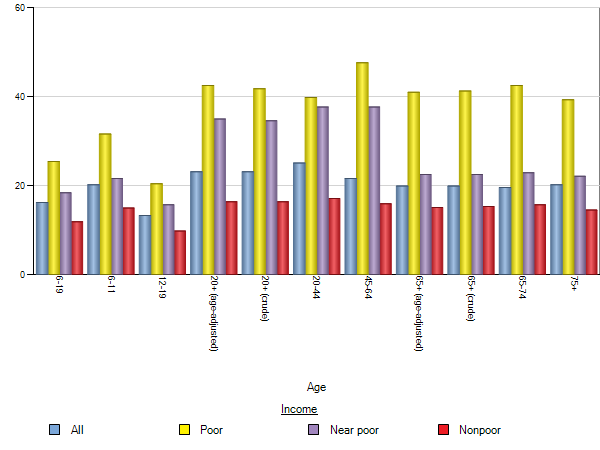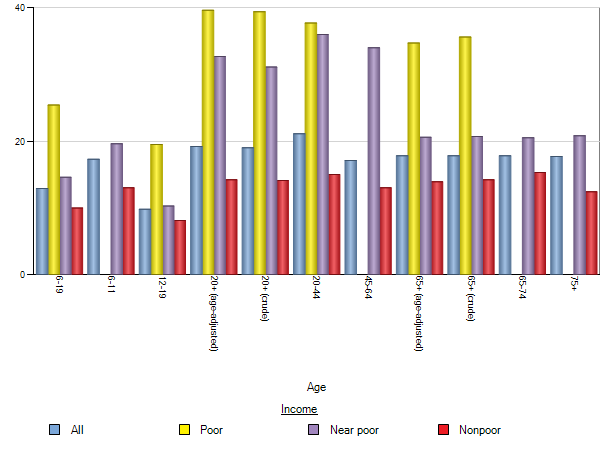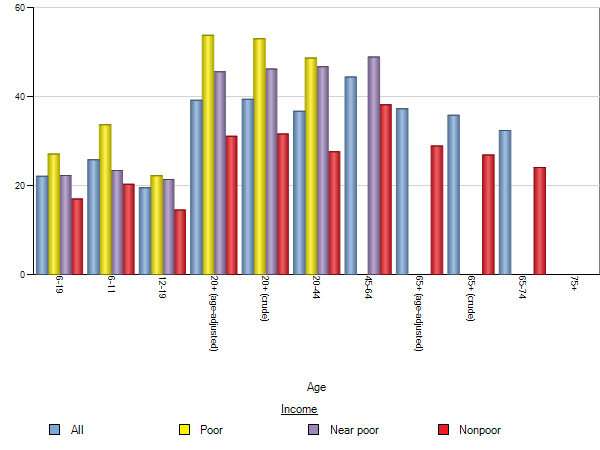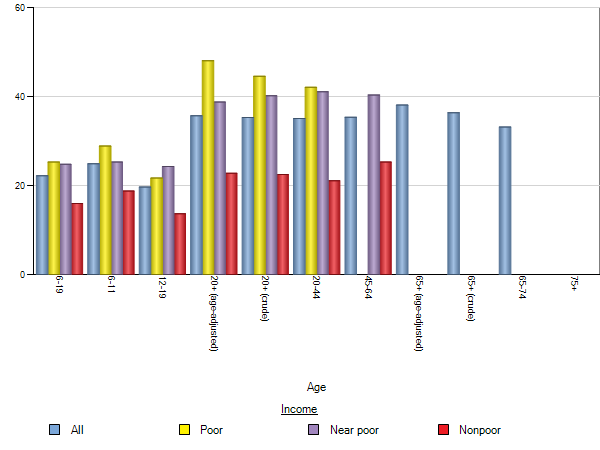Selection of topic
The topic selected is tooth decay in the US. Selection of the topic is based on the fact that it resonates with my field of study. Besides, it is an area of public concern because over the years, there has been growth in cases of untreated tooth decay.
Data
The data used in the analysis are untreated tooth decay in the US for the period between 2005 and 2008 (Source: NHANES). Further, the data are broken down into six age groups, these are, 6-11, 12-19, 20-44, 45-64, 65-74, and 75+ (Center for Disease Control and Prevention, 2016). Also, statistics of untreated tooth decay are available in three different income groups and three ethnicities. Cases of untreated tooth decay are also analyzed based on gender.
Variables
The first variable in the data is age. Data were collected from a sample of people aged from 6 years and above. Age is measured in years and it is an example of discrete data. This is based on fact that age is measured across a set of fixed values. Apart from age, another variable in the data set is race/ethnicity. Only three ethnicities were analyzed in the sample size. These are Non-Hispanic White, Non-Hispanic Black, and Mexican-American. Ethnicity is an example of nominal data because the data will be separated by the naming system (Rao, 2007). Another variable in the data is income. This allows for evaluation of cases of untreated tooth decay based on the income level of the respondents. The data for income, measured in US Dollars, is collected and grouped into poor, near poor and non-poor. This will help in determining whether the level of income has an impact on cases of untreated tooth decay. Income, measured in US Dollars, is an example of continuous data (Rao, 2007). Another variable in the data set is gender. Data is available for both female and male. Gender is also an example of ordinal data (Rao, 2007). Therefore, these attributes will help in understanding the untreated tooth decay, especially in knowing the age groups, income groups, ethnicity and gender that have high rates of untreated tooth decay.
Findings
Mean, an example of descriptive statistics, and ratios were used to analyze the data. The values in the data set are arrived at by estimating the percentage of the entire sample size that has untreated tooth decay. The results in the table show that cases of untreated tooth decay are higher in the age group 20-44 while the age group 12-19 has the least cases of untreated tooth decay (Center for Disease Control and Prevention, 2016). Further, the poor had the highest proportion of untreated tooth decay while the non-poor had the least percentage. This trend is consistent across the three ethnicities. Based on ethnicity, Mexican-American had the highest proportion of untreated cases of tooth decay followed by Non-Hispanic Black while Non-Hispanic White had the least percentage of this condition. In terms of gender, the data show that male respondents had higher cases of untreated tooth decay across all the ethnic and income groups than females. Therefore, based on the finding, it can be concluded that a male Mexican-American aged between 20 and 44 has a high probability of having untreated tooth decay
Graphs
The results of untreated tooth decay can be represented using clustered column graphs. The graphs of all the age groups are presented below.




(Source of graphs – Center for Disease Control and Prevention, 2016).
References
Center for Disease Control and Prevention. (2016). Interactive tables and databases. Web.
Rao, K. V. (2007). Biostatistics: a manual of statistical methods for use in health, nutrition and anthropology. New Delhi: Jaypee Brothers Publishers.